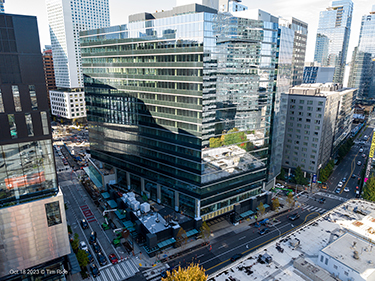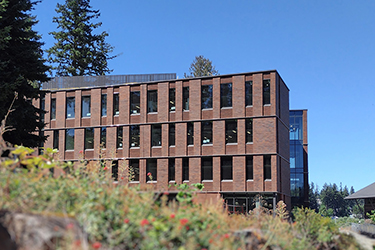|
Subscribe / Renew |
|
|
Contact Us |
|
| ► Subscribe to our Free Weekly Newsletter | |
| home | Welcome, sign in or click here to subscribe. | login |
Environment
| |
 |
April 25, 2024
Curbing construction’s carbon impact from all angles
Lease Crutcher Lewis

Plant
|
By now, this staggering number will be familiar to many: 40 percent of the world’s greenhouse gas (GHG) emissions come from buildings — constructing them, running them and retiring them. These are the places where we work, learn, heal, discover life-saving cures and govern. But they also play an outsized role in changing the climate.
In the past couple of decades, the A/E/C industry has made huge strides to curb the impacts and help new commercial buildings operate more efficiently. Net-zero energy and high-performance buildings have become commonplace. The result is that operational-carbon emissions linked to buildings across the U.S. have fallen by a third since 2005, even as the volume of buildings has grown.
But collectively, we can do much more to stem the tide and reduce the embodied carbon generated during the construction of new buildings or avoid generating as much by renovating existing buildings.
On both sides of the carbon ledger—whether it’s reducing a project’s operational carbon or embodied carbon—our industry has the potential to drive meaningful change toward a more sustainable built environment.
UNDERSTANDING CLEAN BUILDINGS STANDARDS
For existing commercial buildings, coming improvements related to operational carbon may not be voluntary.
The state of Washington has taken a leading role in enforcing new energy-efficiency standards that could influence how other states implement strategies for decarbonization.
In 2019, the state passed the Clean Buildings Act (CBA). The resulting Clean Building Performance Standards (CBPS) set by the Department of Commerce took effect in July 2021 with the goal of improving the operational efficiency of our existing commercial building stock. By 2026, buildings larger than 220,000 square feet must meet minimum energy performance (as measured by Energy Use Intensity, or EUI). The following year, buildings 90,000 square feet and above will fall under the same energy compliance requirements. A year later, the requirement will hit buildings 50,000 square feet and larger, and so on.
Owners who don’t meet the requirements by the deadline will face fines until they retrofit their building to meet the target EUI.
While many owners are experts at navigating building codes, permits and other regulations that inform building alteration decisions and financing, the CBPS primarily impacts existing buildings — not buildings underway — and has a dictated timeline for improvements.
TAKING A FIRST STEP
The first step to assessing the impact of the CBPS is to understand your building’s current state, energy use, operations and management and what base target EUI your building must meet by which deadline. If you don’t already know your building’s energy use, Energy Star Portfolio Manager can be a good place to start for collecting information. Some buildings are already tracked through the city of Seattle’s Tune-Up program.
Either way, owners should hire or consult with an energy auditor or qualified professional to help them understand their building’s target EUI and, if necessary, what they will need to modify to meet the energy performance metrics.
Once owners have a clear understanding of where their building ranks, they can begin making informed decisions regarding phased upgrades and operational changes.
Updates could be a simple switch to LED lighting paired with local rebates to offset the costs, installing submeters, or implementing education programs to influence user-behavior. For other buildings, it could require bigger steps, like building envelope modifications, or substantial MEP upgrades, which require lengthy permit processes and significant capital funding. There are local and federal funds available to offset some of the costs as well as C-Pace financing.
Other strategies might include upgrading electrical infrastructure or implementing renewable energy such as solar, micro wind, King County sewer recovery pilot program, while creating building resiliency.
While the timeline may seem far away, it’s important to remember that compliance requires 12 months of energy tracking, so the deadline to be watching is June 1, 2025. Starting right away may allow for time to evaluate options, permitting, design and logistics.
ZEROING IN ON CONCRETE
In addition to delivering more efficient buildings for our clients, Lease Crutcher Lewis is working to minimize jobsite construction waste, exploring how we might phase out gas-powered trucks and equipment in favor of the all-electric kind, and making infrastructure improvements at our equipment yard to support those changes.
But we also recognize that our organization’s greener business practices and jobsite operations are only part of the equation.
The biggest opportunity resides with reducing the embodied carbon impact of the structures we put in place. This covers emissions related to extracting, manufacturing, and transporting the building materials we ultimately use, as well as the impacts of construction and disposal.
The primary culprits in a building’s embodied-carbon impact are structural elements like concrete, the most commonly-used substance in the world behind water. Production of cement, the key binding agent in concrete, is responsible for a whopping 8% of global CO2 emissions on its own.
Global-Warming Potential (GWP) limits for concrete are being imposed by a growing number of jurisdictions and owners. And the latest version of LEED, LEED v5, will emphasize reductions of projects’ embodied carbon. This latest version debuts this spring for public comment and should be available for use in 2025.
Concrete mixes and their carbon impacts vary widely across markets based on the materials available, the manufacturing capabilities available, and how the material is transported. In the Puget Sound region, embodied carbon linked to concrete is lower than the national average in part due to access to waterways for transportation and the quality of local aggregates.
MAKING A NEW COMMITMENT FOR 2024
As a general contractor with self-perform concrete operations, we know we have the ability to influence not only our own projects, but the local market as a whole.
That’s why our in-house sustainability council has analyzed historical internal data to measure our annual concrete usage and associated embodied carbon. While our standard concrete practices have consistently produced lower carbon than the local average, Lewis is encouraging owners and project partners to move the needle further. As an enterprise, we have committed to tracking ready-mix concrete placed on our projects and have set an internal goal in 2024 to reduce the embodied carbon of our concrete placements by 5% over last year’s data.
We’ve met with major local concrete suppliers and structural engineering partners to discuss opportunities to use lower-carbon mixes that minimize the amount of cement with little-to-no increased costs.
We’re also developing test cases for the use of cement replacements—or supplementary cementitious materials (SCMs)—including high volumes of typical industrial byproducts like fly ash and slag and new SCMs being added to the market. In addition, we are testing mixes with alternate materials like biochar that would otherwise release carbon and methane and which are now captured in concrete. We’ve received approval to use these non-standard mixes on active projects. We continue to test new low-carbon mixes to better understand their viability in standard construction applications.
Outside of what goes in the concrete, our project teams thoroughly evaluate schedule and sequencing requirements to refine the necessary finishing and cure times for the various mixes we use. In some cases, this reduces the amount of cement required, using time to our advantage to reach the design strength.
Buildings are a major contributor to global warming, and providing information about different building practices allows for more informed choices. The ultimate goal is to share our learnings and enable widespread use by the entire local industry.
Julianna Plant is a Seattle-based senior preconstruction manager at Lease Crutcher Lewis, leading the company’s sustainability initiatives.
Other Stories:
- Creativity and innovation are hallmarks of sustainability at PDX Airport
- Making old buildings new again: the case for adaptive reuse
- Promoting residential adaptive reuse in Seattle through policy
- Hiding in Plain Sight: Sustainability and resilience beyond the terminal
- Reducing embodied carbon in concrete construction
- A blueprint for environmental responsibility in construction
- Old building, new tricks: Designing adaptive reuse for long-lasting relevance
- Harnessing the potential of mixed-use communities
- Implementing aggressive water goals
- Toward a path to zero carbon: building renovations and circular economy principles
- A primer on campus decarbonization in Washington




